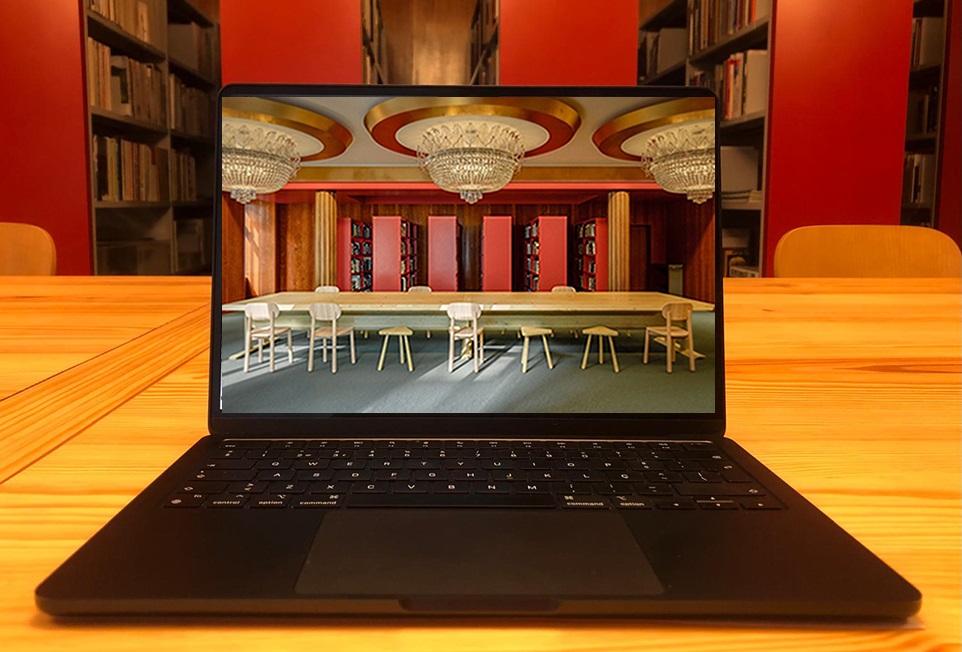
MUDE now
Video of the reopening of the Museum building on 25 July 2024. Credits: José Barbosa/CML
Long-term exhibition
WHAT ARE THINGS FOR? PIECES FROM THE MUDE COLLECTION 1900-2020
Floor 3
Programme and Curatorship: Bárbara Coutinho
Research and curatorial assistance: Inês Correia, Anabela Becho, Inês Matias, Madalena Galvão, Conceição Toscano, Pedro Oliveira, Daniela Esteves, Ana Maria Cunha, Carolina Santana, Madalena Carita, Patrícia Ferreira, Vera Brito
Exhibition design: Coletivo Warehouse
Graphic design: Gonçalo Fialho
The exhibition "What are things for?" aims to re-read the history of design and present Portuguese design in context and as a design process. Rather than showing the design icons in MUDE's collection, the aim is to question how and why products are designed, communicated, perceived, and consumed.
The chronological organisation allows us to go back to the dawn of the 20th century and establish open dialogues between the design pieces and the documentation, highlighting the issues that cut across the different eras and inviting debate on the practices of the past and their projection into the future of each era.
The exhibition design poses a new challenge to museography by prioritising the reuse of various materials from the MUDE construction site that would otherwise go to waste. This curatorial decision makes it possible to reduce waste and the amount of debris as much as possible, investing in the idea of promoting a circular economy, making the exhibition solution a real manifestation of the museological intention to debate the current consumer society and the need to implement the values of economic degrowth.
Starting in September, this exhibition will feature new fashion pieces to replace those that have been removed to ensure their preservation. The curatorial discourse and exhibition centres remain the same, but the dialogues are renewed. The rotation of pieces gives the exhibition greater dynamism, allows visitors to discover the diversity of the MUDE collection and ensures the conservation of the pieces.
This renovation marks another edition of ModaLisboa at the Museum, and the exhibition now includes 49 new pieces from 42 national and international designers/brands: Chanel, Christian Dior/John Galliano, Dirk Van Saene, Emanuel Ungaro, Gucci/Tom Ford, Lara Torres, Martin Margiela, Miguel Rios, Ossie Clark, Paco Rabanne, Pierre Balmain, Prada, Ricardo Andrez, Valentino e Versace, mantendo-se representados: Alves/Gonçalves, Azzedine Alaïa, Christian Dior, Christian Lacroix, Dino Alves, Dries Van Noten, Jean Dessès, Jean Paul Gaultier, Jean-Charles de Castelbajac, José António Tenente, Luís Buchinho, Manuela Gonçalves, Maria Gambina, Miguel Flor, Nuno Baltazar, Pierre Cardin, Schiaparelli, Sonia Rykiel, Storytailors, Thierry Mugler, Yohji Yamamoto e Zandra Rhodes.
JOÃO MACHADO: POÉTICA VISUAL exhibition
Floor 4
28 June - 8 February 2026
Curatorship: Francisco Providência
Exhibition Design and Graphic Design: united by
This exhibition revisits the graphic work of João Machado, highlighting the poetic dimension of his work and the way in which it has developed into a very distinctive identity in terms of composition and colour. In addition to a chronological contextualisation, the exhibition offers a reading of the different phases of his work through five thematic groups and invites visitors to reconstruct or reinvent some of João Machado's posters through interactive elements.
João Machado (1942) is a key figure in the history of graphic design in Portugal, and the quality of his work over more than 40 years has been recognised both nationally and abroad. As an author, he favours posters and illustration (the areas where his identity has gained the most expression), but he also stands out in philately, editorial, and corporate design.
As well as taking part in numerous group exhibitions and graphic design biennials around the world, João Machado's work has also been presented in solo exhibitions in various galleries and museums and honoured with various national and international awards.
In 2023, he donated the ‘João Machado Collection’ to MUDE, a collection that has a high patrimonial, cultural, and artistic value due to its cohesion, unity, and temporal and typological representativeness.
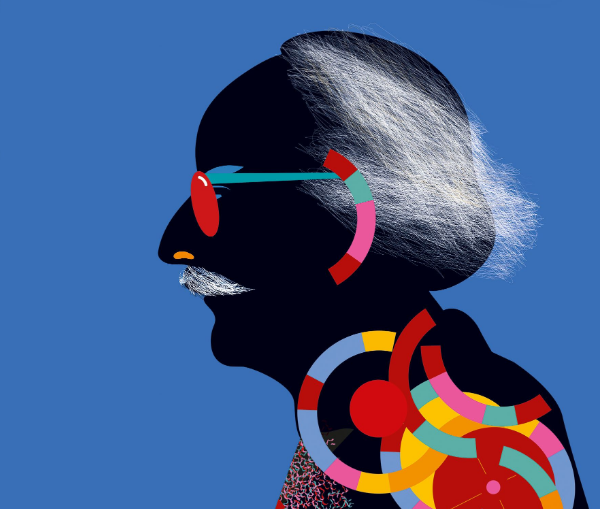
João Machado. Self-portrait poster 2023 (detail)
SPECTRES exhibition
4 October 2025 – 11 January 2026
Partnership between MUDE – Museu do Design and the Lisbon Architecture Triennale
MUDE programmer: Bárbara Coutinho
Curatorship: Ann-Sofi Rönnskog e John Palmesino, Territorial Agency
Exhibition design: Fernando Brízio
Graphic Design: The Royal Studio
MUDE is once again participating in the Lisbon Architecture Triennale, hosting one of the three central exhibitions of the Seventh Edition, How Heavy Is a City?
The exhibition 'Spectres' is part of MUDE's programme as it continues the museum's ongoing focus on the needs of Planet Earth, questioning the ways in which we inhabit territories and the need to respect all forms of life. It is urgent to move from reflection and debate to the implementation of ideas that consider the importance of living in synergy with the Ecosphere.
The ‘Spectres’ exhibition presents multidisciplinary proposals that reflect the transformative potential of collective creative processes and experimental research currently underway, where design and architecture, contemporary art, history, science and emerging technologies come together and expand, seeking answers to questions such as: ‘What is a natural landscape?’, ‘How can we rethink water as a common good?’, ‘What is the sound of the Earth?’, ‘Where is sea level?’, ‘How can we welcome alien ecology?’ or ‘How fragile are infrastructures?’.
Thus, with this exhibition, MUDE's programme reinforces the dissemination of different expressions of design as a discipline of project, showing, in this case, the contribution of speculative design to the definition and implementation of new ideas with a view to building a more just and sustainable future.
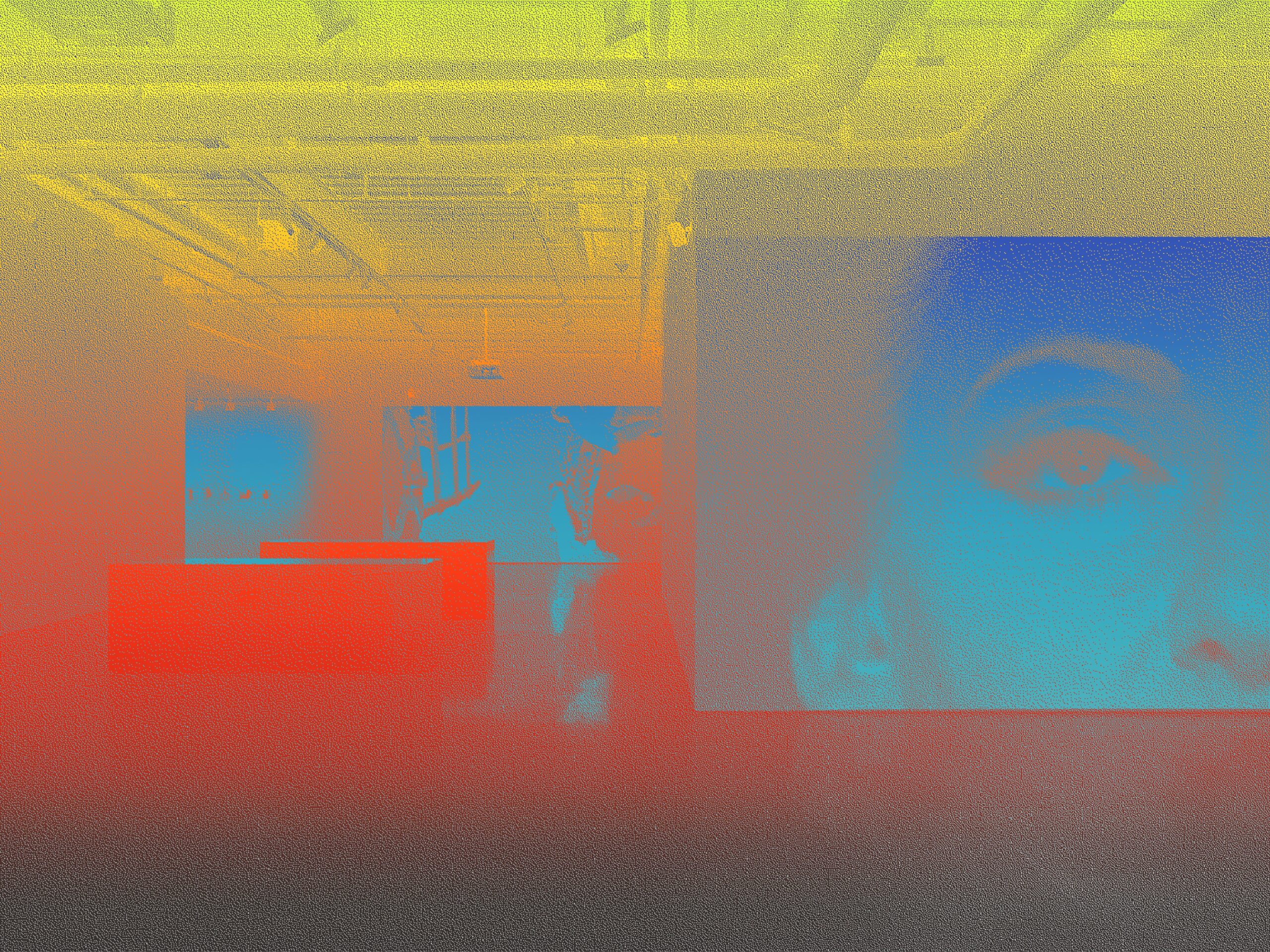
From the original photo: Correspondences, Soundwalk Collective and Patti Smith, 2023
MEU NOME ANTÓNIO exhibition
Photography by Teresa Couto Pinto. 1981-1983
Floor -1
4 December 2025 - 26 April 2026
Curatorship: Bárbara Coutinho
Exhibition design: Luís Saraiva
Graphic design: Francisca Fernandes
Exhibition in collaboration with Terra Esplêndida
In 1981, Júlio Isidro's television programme O Passeio dos Alegres projected nationwide the image and voice of someone who, due to his uniqueness and authenticity, would become one of the leading artists of Portuguese pop music: António Variações (1944-1984). A singer, composer and performer, Variações stood out for the originality of his voice, the inventiveness of his poems and musical compositions, and the unconventional way he dressed and presented himself, challenging the norms of his time. Even after his death, Variações continues to be sung and reinterpreted over the years by different generations, which proves the quality of his work, the revolutionary force of his iconic image, and the reason why he will always be an essential reference in Portuguese music.
The photography exhibition ‘Meu nome António’ (My name is António) presents 85 photographs by Teresa Couto Pinto (Angola, 1955), who was an agent, photographer and, above all, a friend of António Variações. This exhibition features several of the photo shoots she did with the artist between 1981 and 1983, where, image by image, Variações' strong personality, creative freedom, charisma and visual aesthetics are evident, as well as his ease, confidence and complicity with Teresa Couto Pinto. It was from these photo shoots that some of António Variações's iconic images were born, such as the one in which he pretends to stab himself in the chest with a pair of scissors or the one in which he is portrayed with a barber's scissors and a microphone.
In addition to well-known and lesser-known photographs, some of which have never been seen before, this exhibition also features items of clothing and accessories worn by António Variações. Visitors can thus gain a better understanding of his personal style and how he recreated himself through the collective Portuguese identity that he never abandoned, while always drawing inspiration from the cosmopolitan reality of international artistic movements and sounds. The clothes and accessories he designed or chose to wear, the cuts and colours of his hair and beard, and the eye make-up that intensified his gaze, are also part of the uniqueness and timelessness of the man who will always be António Variações.
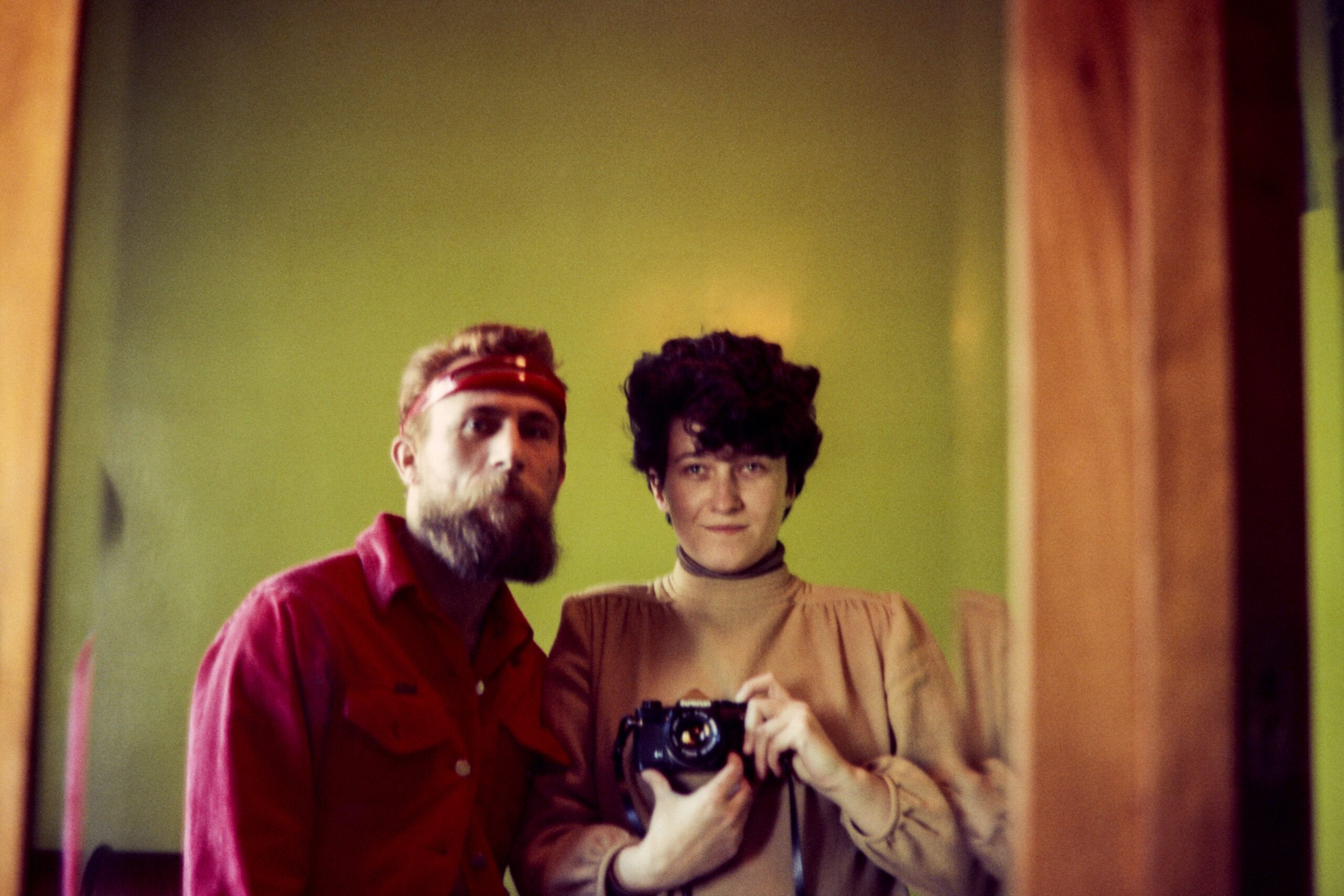
Image: Photograph by Teresa Couto Pinto [1981–1983]
ALEXANDRE FARTO aka VHILS exhibition
Selected Editions. 2008 – 2024.
Piso 1
17 December 2025 - 01 March 2026
Organisation MUDE and Vhilstudio
Curatorship: Pedro Ferreira
Exhibition design: Ema Rodrigues, Rodrigo Lourenço, António Jordão
Graphic design: Pedro Maia, Filipe Lucena, Ana Ganilho
The exhibition Selected Editions 2008–2024 presents a selection of editions by Alexandre Farto/Vhils and the central role they play in his artistic practice, highlighting them as a privileged means of experimentation and collaboration with other artists. The editions also question the concept of art as a unique and exclusive piece, and have been understood as a way of reaching a wider audience, exploring media usually associated with graphic design and advertising. The innovative manual and industrial techniques (particularly printing) that he tests on such diverse media as paper, stone, concrete and earthenware are challenges for his artistic expression and potential factors in the modernisation of the manufacturing processes of the brands and companies that collaborate with him.
The Clay tile collection – an initiative that reinterprets traditional Portuguese tiles through artistic proposals that innovate in technical and formal terms – is presented alongside the exhibition, showcasing Vhils' recent interest in tiles and his usual practice of fostering collaborative projects between artists, designers and architects.
Together, the exhibition and the Clay collection express one of the characteristics that most distinguishes Vhils' work: the constant exploration of different materials and techniques, using unconventional tools, always with a strong communicative intent, expanding the intersections between art, design and visual communication, which is why its presentation at MUDE is of particular interest.

Image: Vhilstudio, Barreiro. FG+SG Architectural Photography
DISPLAY DEPOT
Floor 4
The Display Depot is part of MUDE's policy of incorporating and managing collections with the aim of creating specific conditions for each type of object, both from the point of view of conservation and exhibition.
The opening of the Display Depot offers the public the opportunity to get to know one of the internal workspaces that is usually inaccessible and, at the same time, allows each visitor to discover part of the graphic work in MUDE's collection, before it is presented in exhibitions according to a particular curatorial vision.
1st and 3rd Saturdays of the month, 11am, by prior appointment via email to mude.educativo@cm-lisboa.pt.
Admission: the price of a temporary exhibition, subject to discounts and free admission.
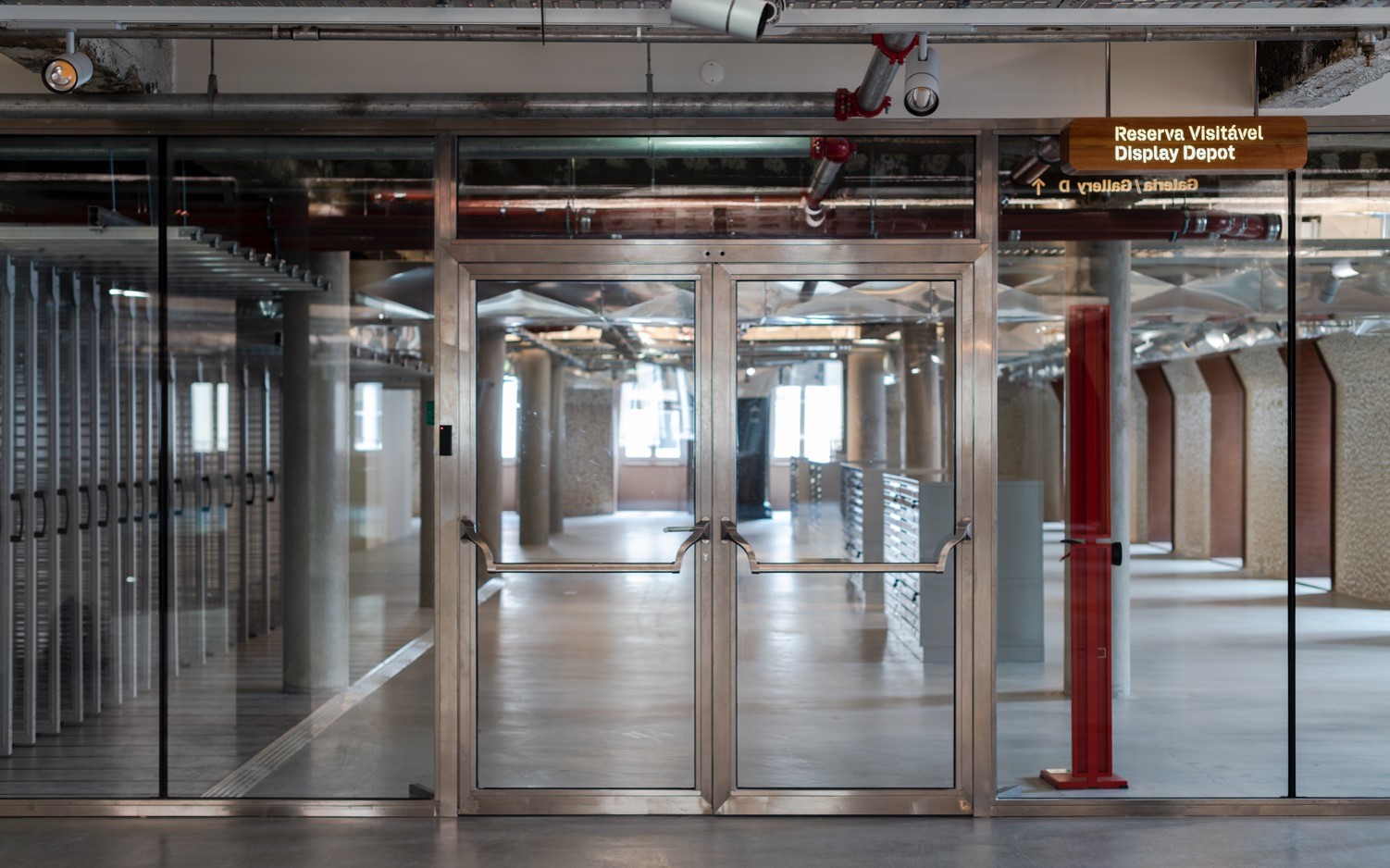
Photo: MUDE/Luísa Ferreira
EDUCATIONAL ACTIVITIES PROGRAMME
General guided tours
From 9 January 2026, general guided tours of the exhibitions will resume, in Portuguese or English.
Take the MUDE Guided Tours and learn about the details of each exhibition, for just €2 more than the ticket price.
Fridays
6pm: guided tours in English (exhibitions to be confirmed)
Saturdays
11 a.m. (1st and 3rd Saturday of each month): guided tour in Portuguese of the Visitable Reserve
3 p.m.: guided tour in Portuguese of the exhibition ‘João Machado: Visual Poetics’
4pm: guided tour in Portuguese of the exhibition ‘What Are Things For? Pieces from the MUDE Collection 1900-2020’
Sundays
11 a.m.: guided tour in Portuguese of the exhibition ‘My Name is António: photography by Teresa Couto Pinto. 1981-1883.’
3 p.m.: guided tour in Portuguese of the exhibition ‘ALEXANDRE FARTO aka VHILS. Selected Editions. 2008-2024.’
Registration via email at mude.educativo@cm-lisboa.pt or at the MUDE reception desk up to 30 minutes before the start of the visit. Participation is subject to the maximum capacity of each exhibition space. Admission: ticket price + €2.
Guided tours and workshops for schools
From Tuesday to Friday, between 10:30 a.m. and 5:00 p.m., by prior appointment, up to two weeks before the desired date, via email: mude.educativo@cm-lisboa.pt.

Photo: MUDE/Luísa Ferreira
The MUDE Collection
The Collection has 15,000 documentary inventory entries and 20,000 museum inventory entries, in 23 collections and 6 typological design nuclei (Scene; Editorial; Graphic; Fashion; Contemporary Jewellery; Product, including the sub-area Interiors).
Archive: documentation from archives resulting from the professional practice of designers, the initiative of associations and collectives, or the actions of public institutions with responsibility for design policy. This documentation allows for the investigation, exhibition and understanding of design in context and as a creative process and can be consulted at the Design Library of the Documentation and Information Centre, by appointment. Main collections: B2 Atelier de Design/Salette e José Brandão; Helena Cardoso; MR-D | Miguel Rios Design. Information regarding archival documentation is being studied so that it will be available in the online Collection.
Library: specialised in design, with the aim of processing, organising, preserving and making its documentary collection available to users. The bibliographic materials are structured into a general collection and special collections. Main collections: António Garcia; Helena Cardoso; João Machado; B2 Atelier de Design/Salette e José Brandão; Centro Português de Design. Consult and research our online collection (link nyron).
Scene Design: scenography, costumes, and props designed for different artistic expressions and/or performances involving stage and performance art. Currently, this nucleus consists of the Teatro da Cornucópia/Cristina Reis collection. Information regarding this collection is being studied so that it will be available in the online Collection.
Editorial Design: printed and digital publications incorporated and/or integrated into The MUDE Collection for their graphic value for editorial purposes. They can be consulted in the Design Library of the Documentation and Information Centre, by appointment. Main collections: António Garcia; Carlos Rocha; João Machado; B2 Atelier de Design/Salette e José Brandão. Consult and research our online Collection (link nyron).
Graphic Design: a nucleus covering 100 years of professional practice in graphic design in the country, providing consistent material for research into the history of design in Portugal. Main collections: Ilustração e Banda Desenhada; António Garcia; Carlos Rocha; João Machado; B2 Atelier de Design/Salette e José Brandão; Belarte. Consult and research our online collection (link inweb). Information relating to this nucleus is currently being studied so that it will be available in the online Collection.
Fashion Design: representative nucleus of the evolution of fashion design and its different perspectives during the 20th and 21st centuries, in Portugal and abroad. Main collections: Francisco Capelo; Nuno Baltazar; Moda Viagem 1965-1975; Maria Gambina; Storytailors; Helena Cardoso. Consult and explore our online Collection (link inweb).
Contemporary Jewellery: a nucleus that reflects the growing presence of author jewellery, in recognition of this field and its specificity among the various expressions of design. Consult and explore our online Collection (link inweb).
Product Design: representative core of the evolution of different perspectives on product design during the 20th and 21st centuries, in Portugal and abroad. It includes sets of pieces specifically designed for a particular domestic or public environment, providing an understanding of interior design and the importance of its preservation as heritage. Main collections: Francisco Capelo; Carlos Galamba; Daciano da Costa; António Garcia; Eduardo Afonso Dias. Consult and explore our online Collection (link inweb).
The MUDE Collection also includes the Edifício-sede BNU collection, embodying the museum's strategy of recognising the Museum Building itself as a living archive, considering also its movable and integrated cultural heritage. Information about this collection is currently being studied so that it will be available in the online Collection.
Planning your visit
Contribute to everyone's safety and comfort by respecting the following rules.
You may not:
- Enter with pets, except guide dogs;
- Eat, drink, and smoke in the interior spaces and on the terrace;
- Climb on the flower beds;
- Leave trash in the interior spaces and on the terrace;
- Touch exhibits and shop windows, except where indicated;
- Flash photography;
- Carry rucksacks, bags, and large objects;
- Talk loudly;
- Make calls or use mobile phones during guided tours and educational activities;
- Run in exhibition spaces.
NOTE: While the cafeteria is closed, if you need to eat or drink, please go to reception so that the appropriate conditions can be provided.
Opening hours
The museum is closed on Mondays, December 25th, and January 1st.
On the 24th and on the 31st of December, the Museum closes at 4 pm. Last entry at 3:30 pm.
Summer opening hours
April to September
Museum
Tuesdays to Thursdays: 10 am to 7 pm
Friday and Saturday: 10 am–9 pm
Sunday: 10 am–7 pm
Winter opening hours
October to March
Museum
Tuesdays to Thursdays: 10 am to 6 pm
Friday and Saturday: 10 am–8 pm
Sunday: 10 am–6 pm
Library Reading Room
Tuesdays and Thursdays: 10 am - 1 pm
Wednesdays and Fridays: 2 pm - 5 pm
First Saturday of the month: 2 pm - 5.30 pm
Administrative Services
Mondays to Fridays: 9:30 am–5:30 pm
ADULTS
- Long-term exhibition ‘What things are for’ €13
- Temporary Exhibitions: 11€
- Full ticket (long term + temporary) 15€
- Guided tour: +2€
50% DISCOUNT
- From 13 to 25 years old.
- Students.
- = or over 65.
- Groups of 15 or more.
- Lisboa Card.
- Protocols with third parties.
FAMILY PASS
- Up to 2 adults with children up to 18 years old: 50% discount.
SCHOOL GROUPS
- Without a guided tour, but with a school certificate: free of charge.
- With a guided tour: €1.5 per student.
- Visit and workshop: €3 per student.
FREE ADMISSION
- Fridays: 5pm–8pm or 9pm for residents of the Lisbon municipality.
- Sundays: 10am–2pm for residents of the Lisbon municipality.
- International Museum Day.
- Children up to 12 years old.
- Culture Pass [Lisbon residents under 23 and over 65 (inclusive) upon presentation of ID card].
- Visitors with a proven disability of 60% or more and a companion.
- Teachers, tourism, and media professionals in working conditions.
- Unemployed people.
- Researchers in the exercise of their functions.
- Members: APAC, APOM, ICOM, and ICOMOS.
- Institutional sponsors.
- CML Employees and Lisbon Municipal Companies.
How to get here
Train: Cascais Line, get off at Cais do Sodré station; North Line, get off at Santa Apolónia station (these stations are connected to the Metro); Sintra Line, get off at Rossio station (5 minutes walk from MUDE).
Metro: Blue Line, get off at Terreiro do Paço or Baixa Chiado stations (3 to 5 minutes walk from MUDE); Green Line, get off at Rossio station (5 minutes walk from MUDE).
Aerobus: Line 1, get off at Rossio.
Parking: Praça do Município, Praça da Figueira, Rua Nova do Almada, Restauradores.
Boat: Cacilhas connection, get off at Cais do Sodré (there is a Metro connection); Barreiro connection, get off at Terreiro do Paço (3 minutes walk from MUDE).
Bus: 711, 728, 732 and 759 (get off at Praça do Comércio), 736 (get off at Rossio).
Tram: 12E and 28E (exit at Rua da Conceição), 15E and 25E (exit at Praça do Comércio), 54E (exit at Rua do Ouro).
Bicycles: city centre cycle path network (parking on Rua do Comércio and next to the Paços do Concelho building).
Accessibility and Safety
MUDE's building has been adapted with barrier-free spaces for visitors with reduced mobility. All the museum's floors and public access are equipped with lifts and ramps. All the exhibitions have information in Braille (ask at reception).
The reception team is available to inform you of any accessibility issues and provide assistance if necessary.
The security team and the soundless video surveillance cameras (duly identified) guarantee the safety of all visitors and staff, as well as the exhibits.
Ramps
The building has several ramps, both outside and inside, that allow wheelchairs to circulate in all areas.
Elevators and platform elevators
Support from a security guard, if necessary.
Sanitary facilities
Equipped and adapted for people with reduced mobility or in wheelchairs.
For everyone, regardless of gender.
For women.
For men.
Spaces
On the museum's 8 floors, there are areas for leisure, education, reflection, debate, and contemplation, as well as exhibition and service spaces.
Reception Floor 0
Information and ticket office (purchase tickets up to 30 minutes before the museum closes). Free lockers, stroller parking, and umbrella stands.
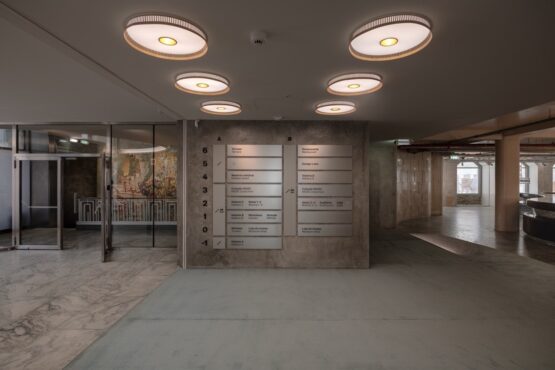
Design Library Floor 1
Reading room for consulting the documental, bibliographic, and archival collections. To access the books, ask the librarian or room assistant for support. This is a space for reading, study and research. We would appreciate your understanding to maintain the conditions for this.
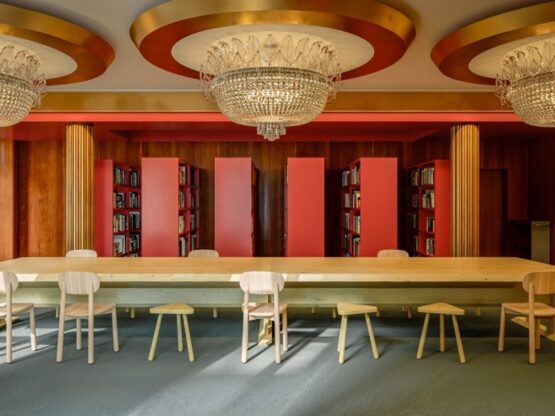
Cafeteria Floor 2 (opening soon)
With furniture evoking traditional Portuguese cafés. Currently, it is only available as an exhibition space.
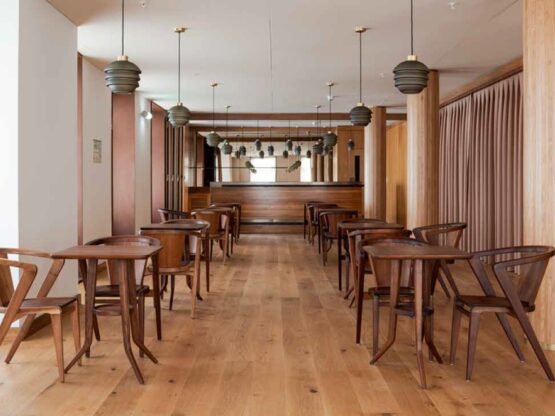
Display Depot Floor 4
Graphic design.
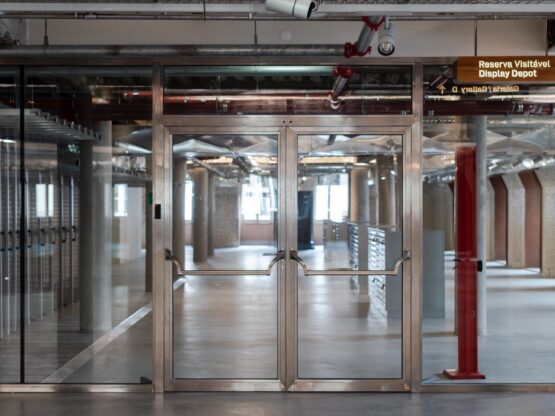
Restaurant Floor 6 (opening soon)
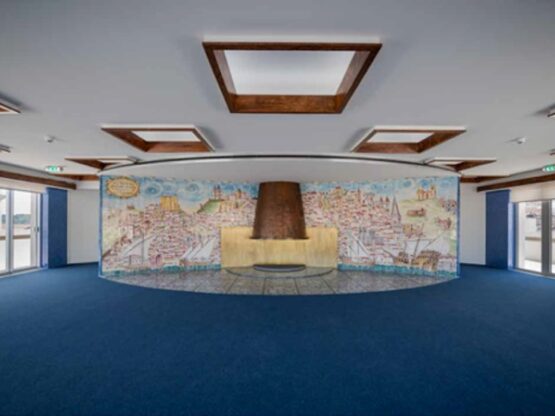
Store Floor 0
With publications from MUDE, national and international editions, furniture, decorative/utility objects. Same opening hours as the Museum.
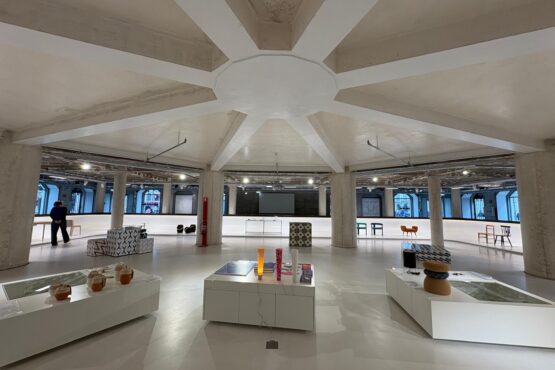
Educational Spaces Floor 2
Workshops for activities planned by the museum with schools, families, and groups by prior appointment.
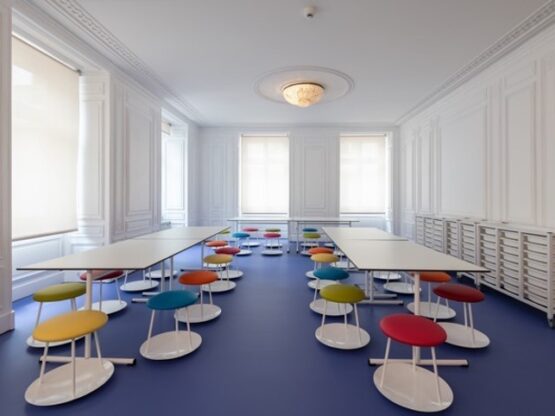
Auditorium Floor 2
With a seating capacity of 177 and fully equipped.
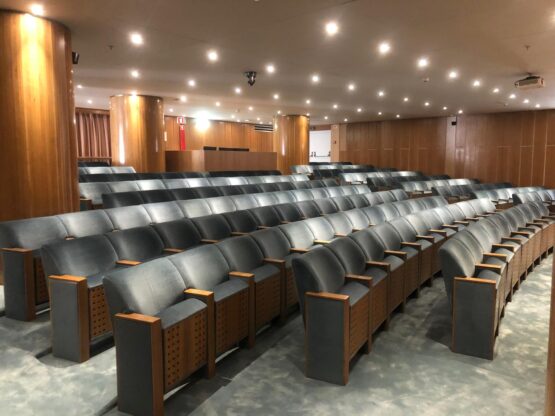
Design Labs Floor 5 (opening soon)
A place for presenting and debating experimental projects.
Designer residencies are by invitation or self-proposal.
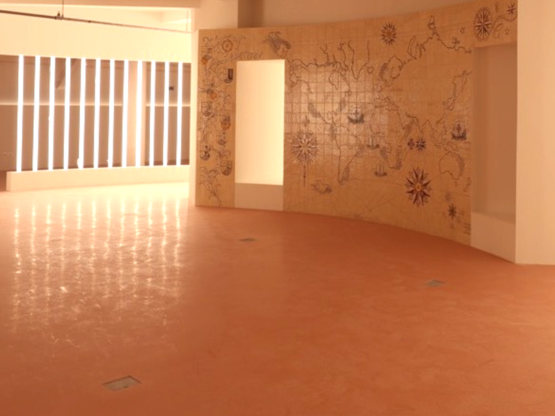
Green Roof Top Floor 6
Viewpoint with a privileged view over Lisbon and a seating area with native, Mediterranean, and xerophytic species, which are not very demanding in terms of water consumption and are compatible with the local weather conditions.
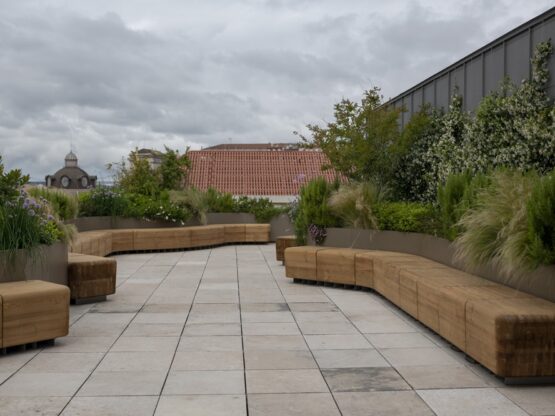
Photos: Luísa Ferreira | Simulations: 18_25
MUDE later

Photo: Teixeira Duarte - Audiovisual Center
THE BUILDING ON EXHIBITION
MUDE, a Lisbon City Council's cultural centre, reopened its building to the public on July 25th 2024 with the exhibition BUILDING ON EXHIBITION, to be visited before receiving other exhibitions, cultural activities from the museum's programme and items from its collection.
Once the exhibition is over, an information system is being prepared that will allow visitors to learn in situ about the architecture, evolution and transformations that the building has undergone throughout its history.
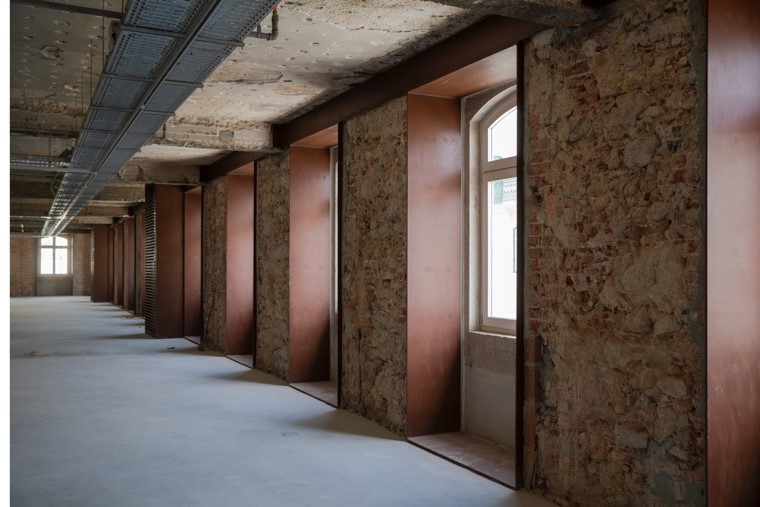
Exhibition gallery. Floor 3
Contacts:
MUDE – Design Museum
Rua Augusta, 24
1100-053 Lisboa
Telephone: (+351) 218 171 892
Email: mude@cm-lisboa.pt
Library and Archive:
mude.biblioteca@cm-lisboa.pt
Communication:
mude.comunicacao@cm-lisboa.pt
Conservation:
mude.colecoes@cm-lisboa.pt
Education:
mude.educativo@cm-lisboa.pt
Mailing address:
Rua de São Julião 111, 1100-524 Lisboa
